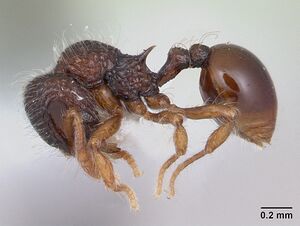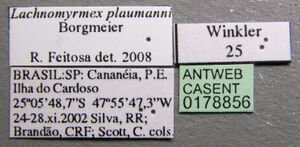Lachnomyrmex plaumanni
| Lachnomyrmex plaumanni | |
|---|---|

| |
| Scientific classification | |
| Kingdom: | Animalia |
| Phylum: | Arthropoda |
| Class: | Insecta |
| Order: | Hymenoptera |
| Family: | Formicidae |
| Subfamily: | Myrmicinae |
| Tribe: | Attini |
| Genus: | Lachnomyrmex |
| Species: | L. plaumanni |
| Binomial name | |
| Lachnomyrmex plaumanni Borgmeier, 1957 | |
Feitosa and Brandão (2008) - This is species has been collected from northern Argentina to southeastern Brazil, along the submontane areas of the Brazilian Atlantic Forest (400–1200m). Despite the constant presence of L. plaumanni in leaf liter samples from the Atlantic Forest, all attempts to maintain colonies in artificial conditions so far have failed. Gynes and workers usually die a few days after capture. There is a single record of a L. plaumanni worker foraging in the vegetation. It was collected manually in a bromeliad fixed in a high live tree from Serra do Itapeti, state of São Paulo, Brazil (M.S. Morini, pers. comm.).
Identification
Feitosa and Brandão (2008) - Body sparsely covered by short, fine rugae; promesonotum elevated minimally above propodeum level; apex of propodeal spines curved downwards; teeth of propodeal lobes swollen and extremely reduced; dorsum of postpetiole with about six long hairs; first tergite of gaster entirely devoid of long flexuous hairs. Lachnomyrmex plaumanni is one of the smallest species in the genus and can be immediately recognized by the combination of sparse sculpturation, propodeal spines curved downwards, and dorsum of postpetiole with about six long hairs.
Keys including this Species
Distribution
Latitudinal Distribution Pattern
Latitudinal Range: 25.68015° to -27.818°.
| North Temperate |
North Subtropical |
Tropical | South Subtropical |
South Temperate |
- Source: AntMaps
Distribution based on Regional Taxon Lists
Neotropical Region: Argentina, Brazil (type locality), Costa Rica.
Distribution based on AntMaps
Distribution based on AntWeb specimens
Check data from AntWeb
Countries Occupied
| Number of countries occupied by this species based on AntWiki Regional Taxon Lists. In general, fewer countries occupied indicates a narrower range, while more countries indicates a more widespread species. |

|
Estimated Abundance
| Relative abundance based on number of AntMaps records per species (this species within the purple bar). Fewer records (to the left) indicates a less abundant/encountered species while more records (to the right) indicates more abundant/encountered species. |

|
Biology
|
Castes
Images from AntWeb
   
| |
| Worker. Specimen code casent0173876. Photographer April Nobile, uploaded by California Academy of Sciences. | Owned by MZSP, Sao Paulo, Brazil. |
   
| |
| Worker. Specimen code casent0178856. Photographer April Nobile, uploaded by California Academy of Sciences. | Owned by CAS, San Francisco, CA, USA. |
Nomenclature
The following information is derived from Barry Bolton's Online Catalogue of the Ants of the World.
- plaumanni. Lachnomyrmex plaumanni Borgmeier, 1957: 125, figs. 47-52 (w.q.) BRAZIL. See also: Feitosa & Brandão, 2008: 34.
Unless otherwise noted the text for the remainder of this section is reported from the publication that includes the original description.
Description
Worker
Feitosa and Brandão (2008) - Lectotype. HL 0.65; HW 0.63; ML 0.19; SL 0.38; EL 0.11; WL 0.71; PSL 0.14; PL 0.30; PPL 0.14; GL 0.79; TL 2.77; CI 97; SI 60; OI 17. Workers (n=58). HL 0.57–0.69; HW 0.57–0.68; ML 0.17–0.20; SL 0.35–0.42; EL 0.09– 0.14; WL 0.61–0.80; PSL 0.13–0.15; PL 0.25–0.35; PPL 0.11–0.14; GL 0.68–0.93; TL 2.51–3.07; CI 96–101; SI 56–65; OI 14–22.
Worker description. Color light reddish-brown to dark brown, with appendages lighter. Body sparsely covered by irregular short rugae, somewhat longer and longitudinal on head dorsum; mandibles with short longitudinal striae restricted to basal portion; petiole and postpetiole finely and irregularly rugose. Abundant pilosity on head and promesonotum dorsum; dorsum of petiolar node and postpetiole with about four and six long hairs, respectively; first gastral tergite entirely devoid of long flexuous hairs. Head as long as broad, with vertexal margin strongly convex; frontal lobes laterally rounded; eyes with about six facets on maximum diameter. Promesonotum moderately convex in profile, only discretely higher than level of propodeum; metanotal groove shallow to virtually obsolete; apex of propodeal spines distinctly curved downwards; teeth of propodeal lobes swollen and reduced, with less than one-third of propodeal spines length. Petiolar node moderately elevated, dorsally rounded, and with the posterior face weakly sloped in lateral view; postpetiole feebly convex dorsally and without ventral processes.
Queen
Feitosa and Brandão (2008) - (n=20). HL 0.58–0.71; HW 0.58–0.71; ML 0.17–0.25; SL 0.36–0.44; EL 0.13– 0.19; WL 0.73–0.91; PSL 0.13–0.16; PL 0.30–0.39; PPL 0.13–0.16; GL 0.79–1.02; TL 3.45–2.70; CI 97–102; SI 58–62; OI 21–28.
Differing from worker by the larger eyes, with around 12 facets at maximum diameter; propodeal spines relatively wider basally and with the apexes only minimally curved downwards.
Etymology
Feitosa and Brandão (2008) - Father Thomas Borgmeier (1957) named this species in honor of the Lithuanian entomologist, Fritz Plaumann (1902–1994), collector of the L. plaumanni type-series and known for his exhaustive work on the insect fauna of the state of Santa Catarina, Brazil. Plaumann is considered the most important insect collector of Latin America in the 20th century.
References
- Albuquerque, E., Prado, L., Andrade-Silva, J., Siqueira, E., Sampaio, K., Alves, D., Brandão, C., Andrade, P., Feitosa, R., Koch, E., Delabie, J., Fernandes, I., Baccaro, F., Souza, J., Almeida, R., Silva, R. 2021. Ants of the State of Pará, Brazil: a historical and comprehensive dataset of a key biodiversity hotspot in the Amazon Basin. Zootaxa 5001, 1–83 (doi:10.11646/zootaxa.5001.1.1).
- Borgmeier, T. 1957a. Myrmecologische Studien, I. An. Acad. Bras. Cienc. 29: 103-128. (page 125, figs. 47-52 worker, queen described)
- Feitosa, R.M. & Brandão, C.R.F. 2008. A taxonomic revision of the Neotropical myrmicine ant genus Lachnomyrmex Wheeler (Hymenoptera: Formicidae). Zootaxa 1890, 1-49.
References based on Global Ant Biodiversity Informatics
- Borgmeier T. 1957. Myrmecologische Studien, I. Anais da Academia Brasileira de Ciencias 29: 103-128.
- Favretto M. A., E. Bortolon dos Santos, and C. J. Geuster. 2013. Entomofauna from West of Santa Catarina State, South of Brazil. EntomoBrasilis 6 (1): 42-63.
- Feitosa, R.M. and C.R.F Brandao. 2008. A taxonomic revision of the Neotropical myrmicine ant genus Lachnomyrmex Wheeler (Hymenoptera: Formicidae). Zootaxa 1890:1-49
- INBio Collection (via Gbif)
- Kempf W. W. 1978. A preliminary zoogeographical analysis of a regional ant fauna in Latin America. 114. Studia Entomologica 20: 43-62.
- Kempf, W.W. 1972. Catalago abreviado das formigas da regiao Neotropical (Hym. Formicidae) Studia Entomologica 15(1-4).
- Medeiros Macedo L. P., E. B. Filho, amd J. H. C. Delabie. 2011. Epigean ant communities in Atlantic Forest remnants of São Paulo: a comparative study using the guild concept. Revista Brasileira de Entomologia 55(1): 7578.
- Orsolon-Souza G., C. E. L. Esberard, A. J. Mayhe-Nunes, A. B. Vargas, S. Veiga-Ferreira, and E. Folly-Ramos. 2011. Comparison between Winklers extractor and pitfall traps to estimate leaf litter ants richness (Formicidae) at a rainforest site in southest Brazil. Braz. J. Biol. 71(4): 873-880.
- Rosa da Silva R. 1999. Formigas (Hymenoptera: Formicidae) do oeste de Santa Catarina: historico das coletas e lista atualizada das especies do Estado de Santa Catarina. Biotemas 12(2): 75-100.
- Silva R. R., R. S. Machado Feitosa, and F. Eberhardt. 2007. Reduced ant diversity along a habitat regeneration gradient in the southern Brazilian Atlantic Forest. Forest Ecology and Management 240: 61-69.
- Silva R.R., and C. R. F. Brandao. 2014. Ecosystem-Wide Morphological Structure of Leaf-Litter Ant Communities along a Tropical Latitudinal Gradient. PLoSONE 9(3): e93049. doi:10.1371/journal.pone.0093049
- Suguituru S. S., D. R. de Souza, C. de Bortoli Munhae, R. Pacheco, and M. S. de Castro Morini. 2011. Diversidade e riqueza de formigas (Hymenoptera: Formicidae) em remanescentes de Mata Atlântica na Bacia Hidrográfica do Alto Tietê, SP. Biota Neotrop. 13(2): 141-152.
- Suguituru S. S., M. Santina de Castro Morini, R. M. Feitosa, and R. Rosa da Silva. 2015. Formigas do Alto Tiete. Canal 6 Editora 458 pages
- Suguituru S. S., R. Rosa Silva, D. R. de Souza, C. de Bortoli Munhae, and M. Santina de Castro Morini. Ant community richness and composition across a gradient from Eucalyptus plantations to secondary Atlantic Forest. Biota Neotrop. 11(1): 369-376.
- Ulyssea M.A., C. E. Cereto, F. B. Rosumek, R. R. Silva, and B. C. Lopes. 2011. Updated list of ant species (Hymenoptera, Formicidae) recorded in Santa Catarina State, southern Brazil, with a discussion of research advances and priorities. Revista Brasileira de Entomologia 55(4): 603-611.

